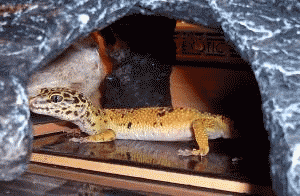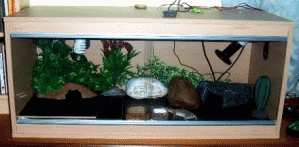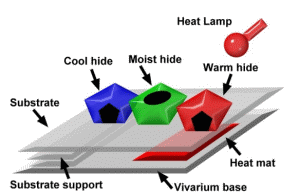Which vivarium?
One of the reasons why leopard geckos are so popular as pets is, because of their small size (8-11 inches for a fully grown adult) they can be comfortably accommodated in a fairly small container.
Be careful not to position the vivarium in full sun or near a radiator or other heat source, as this can lead to sudden and unacceptable temperature rises within the enclosure, which may be harmful to your gecko.

Wooden vivariums have the advantage that you can attach light and heat fittings easily to the inside, but great care must be taken to minimise the risk of it catching fire. Glass and plastic vivariums reduce the fire risk but are more prone to fracture and break. The cost of a good vivarium varies from £50 to £200, depending on the size and make. Recommended makes include Exo Terra and Viv Exotic.
Basic heating
Whichever kind of vivarium you go for, it is essential that it be equipped with one or more heat sources to maintain a fairly steady temperature gradient across the length of the tank, going from 20°C (70°F) at the cool end to 30°C (85°F) at the warm end. (Try to keep temperature variations to within three degrees either end.)
The temperature gradient can usually be achieved with an electrically powered heat mat (8 to 12 W) placed at one end of the tank and controlled by an accurate and reliable thermostat.
For a wooden vivarium, the heat mat must be placed within the tank, but not in contact with the wooden base or sides. Special 'heat mat holders' can be used for this purpose, or you may construct a support from some suitable heat-resistant material. Always allow a small air gap (1 to 2 mm) between the top of the heat mat and any substrate you may place on top of it - this prevents the heat mat from over-heating and either fusing or catching fire.
For a plastic or glass vivarium, the heat mat should be placed beneath the tank, separated from it by a small air gap (again to prevent over-heating), and sitting on an insulating base, such as polystyrene tiles.
The heat mat should cover roughly one third of the base of the vivarium, and the temperature probe of the thermostat situated an inch or two inches above the substrate in the heated end of the vivarium.
Supplementary heating
Sometimes you may need to add another heat source to ensure the correct temperatures are attained. This may be necessary if the vivarium is located in a room that is liable to be below 15°C for extended periods of time.
In either case, ensure that the gecko can never come into direct contact with the heat source, because if it does it may incur a severe burn.
For a wooden vivarium, it is essential that a bulb holder with a ceramic fitting be used, to reduce the risk of fire.
When choosing a thermostat, it is good to go for a reliable make - Microclimate is a good choice as their thermostats come with a five year guarantee.
Always monitor the temperatures
Having equipped the vivarium with its heat source(s) you must now ensure the correct temperature gradient is achieved. It's a good idea to use two digital thermometers, placed at the two ends of the tank, with the temperature probes a few inches above the substrate. Adjust the settings on the thermostat until the desired temperatures are achieved (this may take several days). When the gecko is installed in its vivarium, it is essential that you monitor the temperatures on a regular basis and adjust the thermostat settings if necessary.Lighting
One of the advantages of leopard geckos over other lizards is that they do not require UV lighting. However, you may want to add lighting to the vivarium so that you can more easily view the geckos during the night.
Another optional extra is a low energy (8 W) white light bulb for daytime viewing. On a timer (i.e. timed to turn on in the morning and switch off in the early evening) this can be beneficial for the gecko, making it easier for it to distinguish day from night and thereby assisting its circadian rhythm. This is important if the gecko is housed in a dark room where it may have difficulty knowing when it is day or night.
Hides
Another essential requirement are a set of hides in which the leopard gecko can sleep, rest or just hide away from its pesky owner.
The gecko will also appreciate hides at both the warm and cool ends of the vivarium. The warm hide is especially important as this is where the gecko will often retire to digest its meal. The Exo Terra medium-sized cave is suitable for use as both a cold and warm hide.
Going to town with the decor

Rocks, pebbles and bits of branches can be added, provided these have been carefully sterilised beforehand. Don't over-clutter the vivavarium, as your gecko still needs to get about, and the last thing you want is for him/her to risk life and limb in a semi-lethal army assault course.
Substrate
Regardless of what kind of vivarium you go for, its base has to be covered with a suitable substrate which the gecko can safely move about on. For many years, sand was the preferred substrate, as it is cheap, easily available and gives a nice naturalistic look. The problem is that it is easily ingested by the gecko and can lead to impaction of the stomach and a slow, agonising death.
If you are not concerned with appearances, and/or are on a budget, a perfectly adequate alternative is paper towels, replaced at least once a week. A more attractive but still cost-effective choice is ceramic tiles. These have the advantage of being cheap, easily obtainable (in whatever pattern or colour you desire), easy to fit and - best of all - easy to clean. With tiles, faecal and other organic matter (uneaten food) are easily spotted and removed. Whereas sand and paper towels have to be constantly replaced, the same ceramic tiles can be used over and over again, providing they are regularly cleaned with a suitable, lizard-friendly detergent.

There is no perfect substrate, all have their pros and cons, but ceramic tiles are probably the best option. You can either have these cut to the exact size of your vivarium, or else overlay them to create a staircase effect which your leopard gecko may enjoy climbing.
© James Travers 2014